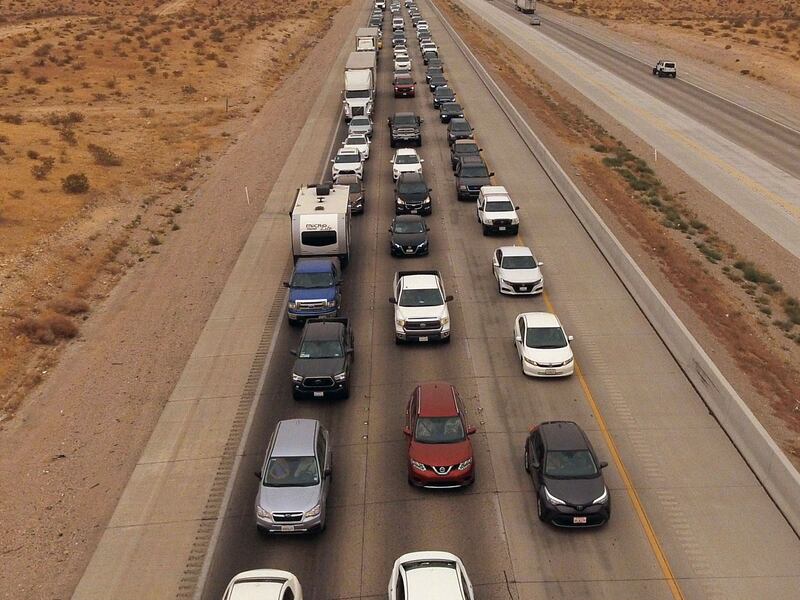As travelers and truckers endure I-15 congestion between Las Vegas and Southern California over the holidays, they may or may not find relief knowing that driving to next year’s family gatherings and bowl games will be less frustrating.
That’s when a temporary fix of widening a 5-mile stretch of the freeway will be completed, the governors of Nevada and California announced recently.
The announcement happened a week after Thanksgiving traffic was reportedly backed up as far as 20 miles from where I-15 crosses the Nevada-California state line.
“The traffic nightmare on southbound I-15 is a rite of passage for motorists on holiday weekends leaving Las Vegas. Since the beginning of the year, traffic volume has continued to increase on the interstate,” according to a Nov. 28 report in the Las Vegas Review-Journal accompanied by photos of the freeway resembling a parking lot filled with cars and semitrailer trucks.
Interstate 15 runs from the Montana-Canadian border and passes through six states before it terminates in San Diego, California. Along the 1,470-mile route through the Mountain West, the freeway picks up traffic from intersections with I-90 in Montana, I-84 in Idaho and Utah, and I-80 and I-70 in Utah before it enters California.
But the congestion creating the most concern stems from a 5-mile, southbound stretch that narrows from three lanes to two between the border town of Primm, Nevada, and the California Department of Food and Agriculture Agricultural Station.

“This five-mile stretch of highway is a critical piece of infrastructure for not only our two states, but for the whole country. However, the hours of traffic deters tourism and goods movement,” said California Gov. Gavin Newsom in a press release, which described I-15 as an “economic lifeline corridor due to its role in the supply chain.”
A 2017 report on the I-15 corridor master plan covering Utah, Arizona, Nevada and California said the freeway “transports $95 billion of commerce annually to and from local communities and the global marketplace” and serves as the primary access for anyone traveling from Las Vegas to Southern California.
With weekend freeway traffic as a backdrop at the Dec. 5 news conference, Newsom gave Nevada Gov. Steve Sisolak credit for pushing California to address the southbound congestion that can make a 113-mile drive from the Nevada state line to Barstow, California, last from three to five hours.
Nevada had widened its side of the freeway to three lanes several years ago and Newsom said Sisolak called to say “we can’t take it anymore. California needs to step up,” according to the Review-Journal.
“When asked on our side of the border ‘What is Caltrans going to do?’ the answer is we have nothing prepared. That all changed when the governor (Sisolak) made the call a few weeks ago, rather than complaining about it, rather than putting press releases out about it,” Newsom said. “You actually picked up the phone and asked if there was something we could do. That’s rather novel in today’s political climate.”
Both governors are Democrats.
For the problematic 5-mile segment of roadway, Caltrans will spend $12 million to turn the roadway’s shoulder into a third lane during periods of peak congestion — primarily Sundays and Mondays.
Construction is expected to begin by mid-spring 2022, with completion anticipated by the end of summer 2022.
The governors acknowledged that creating three lanes of highway out of two is a temporary fix to a problem that needs of a permanent solution.
“We’re not passively interested in trying to episodically solve this. We’re here for the long haul. We want to get this fixed. And I made that crystal clear to my team,” Newsom said.
Both governors noted one solution slowly moving ahead is a high-speed train.
“I got here in 1976 and they were talking about high-speed rail between California and Nevada, and they’re still talking about it. But we’re making progress now,” Sisolak said, according to KNTV.
He was referring to a private venture known as Brightline West, which purchased land in July for a Las Vegas terminal and is working with Nevada and California officials on laying some 260 miles of track for an electric train between Los Angeles and Las Vegas. The company, which operates commuter trains in Florida, hasn’t disclosed a projected completion date for its West Coast project.
Melanie Curry, writing for Streetsblog Cal, offered some alternatives until, and if, a high-speed train becomes reality. She suggested tolls, designated car pool and bus lanes, and promoting public transit between the two cities.
“California may be good at building highways,” she warned, “but it’s a bad habit we need to break.”


